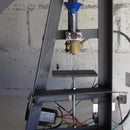Introduction: Motorbike Towing Cradle
Motorbike towing cradle using a car with existing towbar
Step 1: It Was a Dark and Stormy Night, I Was All Alone, and Then It Went Quiet, Very Quiet...
well not exactly, but that's usually the way a good story starts.
Actually I got a call from my son in the day, "my bike just died and it won't start again", yes lad it's called "seized" and it does go kinda quiet, it's what happens when the Yamaha autolube feature packs up, and so was born the need for the "one man bike towing cradle".
Step 2: The Story Continues..
My first attempt involved bolting L brackets onto my existing towbar which had holes to take the bike's axle. It worked but wasn't an ideal solution, no restraining straps and no ramp meant a lot more effort involved, and I had to take off the bike wheel every time.
So after some chitchat with young Karl (a colleague) who described the contraption he used, I came up with the following
Step 3: Requirements
1. An existing towbar
2. a welder
3. angle grinder or cutoff saw,
4. 9 Metres of 1cm thick dropper bar (used in the building trade)
3m for the ramp
6m for the cradle
5. 1 Metre of steel tube, I used a 900mm rectangular 25mm X 40mm cos I had it.
Step 4: Making the Ramp
First the ramp, which hooks onto the cradle, so it's easily taken off, yet remains stable when on. I used 2m of bar to make the ramp, sides of 500mm long and ten sections of 100 mm as the cross pieces to join the sides, alas the ramp angle was too steep so I had to lengthen it to 800mm, (2.6m needed for the longer ramp), a 1m ramp was too long and interfered with the bikes back wheel.
Step 5: The Cradle
Next the cradle, I used about 6m of bar, main sides are 55cm long. I used a cad program to position a photo of the bike at a height above ground that seemed suitable, about 25cm, and then drew the cradle around the wheel.
Prior to welding, it's important to keep the angles as per DXF file, they affect the height of the final product when bolted on to the towbar.
The 2 sides of the cradle are joined with 12cm cross pieces due to the bolt spacing of 10cm on my towbar, pretty much the standard I think, which means the ramp width of 10cm will fit just fine inside the cradle.
Attachments
Step 6: Tube End Detail for Tiedowns
The stabilizing bar for the tiedowns was then welded underneath the cradle, I used chain links welded to the bar ends for the straps to pass through.
Step 7: How Strong Is It?
The cradle will accept a 26 inch bicycle wheel no problem, and is a better solution than the wheel in a boot method or bike in a car style.
I've stood on the end of the cradle while attached to the towbar and it didn't exhibit any flex although the car did squat down another 10cm or so, but then again I spin the dial on a scale to 95, which aint exactly a high score, but not too shabby either.
Step 8: Tips
In use I find that ratcheting down the front suspension also serves to preload the rear of the bike so that it doesn't bounce around so much on the road.
Another thing to do is take off the chain if you're planning a longish ride, it cant be good leaving the gearbox in neutral, let alone the unnecessary wear, while towing.
It took about 10min to take off the tow hitch and put on the cradle, and that includes remembering to put the ramp in the boot, and about 10min fiddling with tiedown straps while holding the bike level...an easy one man operation.
Admittedly this was with my son's 84kg 50cc it might be a bit harder with a bigger bike.
Step 9: The Disclaimer
So far I haven't had any problems with this setup, legal or otherwise, your mileage may vary.
Step 10: Reinforcing Update
While the cradle was strong enough for my sons 86kg 50cc Yamaha bike, it did sway and flex considerably with my 168kg 500cc Bullet.
So I have decided to reinforce the structure at the tie down arms, I did this using 1 piece of steel bar suitably bent so as to fit and weld in place.
The result is a lot more resistant to flex and I drive easier not having to worry about things coming undone.














